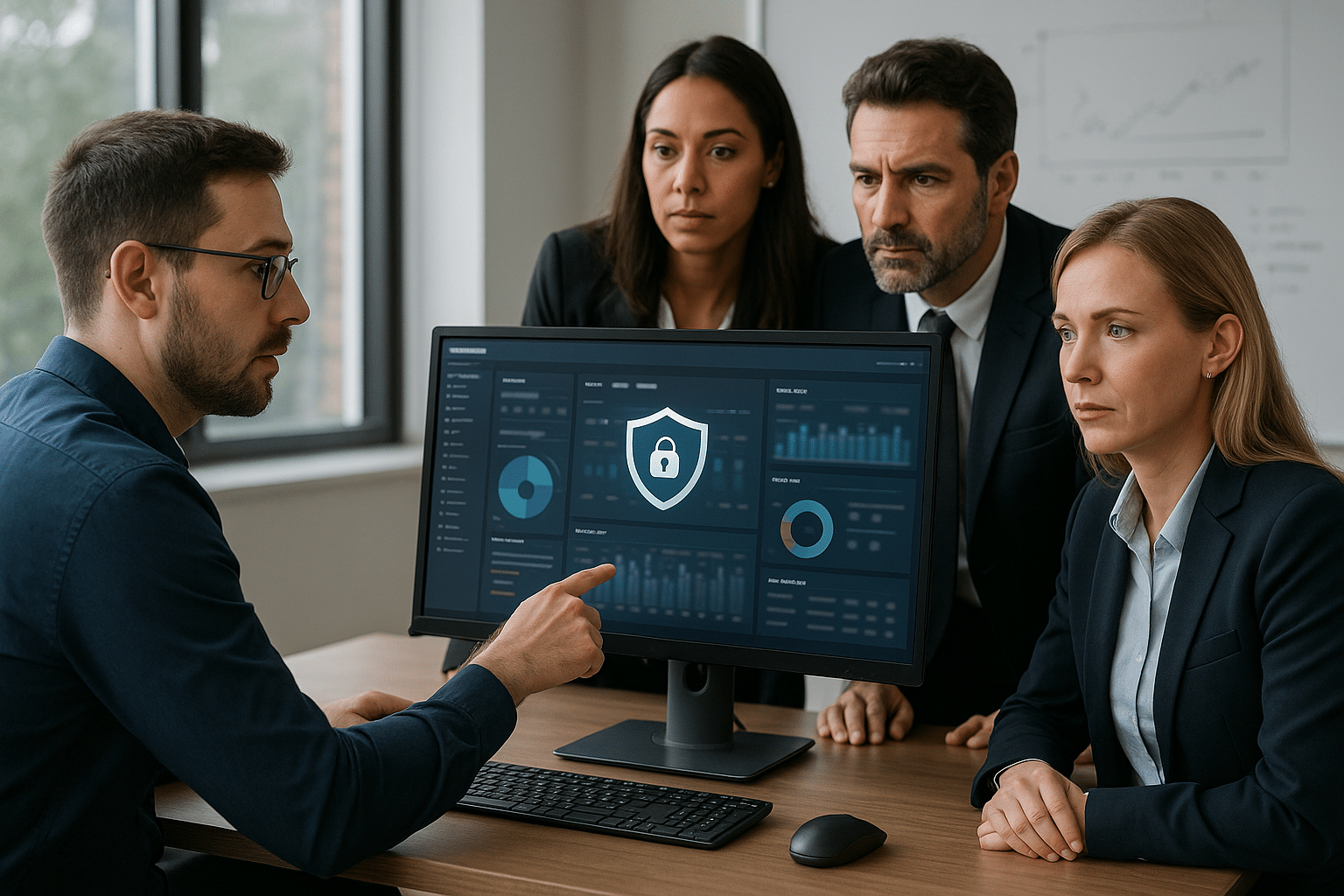As professionals and organizations handling vast amounts of sensitive data, we are expected to manage, protect, and share this data in the most secure and efficient way possible. And so, this guide is designed to delve into the best practices, strategies, and tools necessary to securely share client dashboards, ensuring optimal data transparency.
Data transparency 🧩 is a significant element in fostering trust and enhancing client relationships. It allows stakeholders to understand the state of their investments and assures them that their data is not only being handled professionally but also securely. However, achieving this level of transparency can be challenging, especially considering the rise in data breaches and cyber-attacks.
🔒 Securely Sharing Dashboards: A Key to Professional Data Transparency
Securing client dashboards involves a myriad of considerations – from implementing robust security protocols to ensuring user-friendly interfaces. Whether you’re a data analyst, software engineer, or business owner, the information provided in this guide will be beneficial in understanding the nuances of secure data sharing and how to leverage it for improved data transparency.
Additionally, we’ll explore some of the leading tools and platforms designed to facilitate secure data sharing. These resources not only ensure the integrity and confidentiality of your client’s data but also provide them with a comprehensive view of their data, enhancing the overall user experience.
🔎 What to Expect from this Guide
This comprehensive guide will provide insights into the following key areas:
- Understanding the significance of securely sharing client dashboards and its role in professional data transparency.
- Exploring the various challenges and potential risks associated with data sharing and how to mitigate them.
- An overview of the different security protocols and measures essential in protecting client data.
- An examination of the leading tools and platforms designed to facilitate secure data sharing.
- Strategies and best practices for effectively communicating data transparency to clients and stakeholders.
While this guide covers a lot of ground, it’s essential to remember that securing client dashboards is a continuously evolving process, requiring constant updates and improvements. It’s our responsibility as professionals to stay updated with the latest advancements and trends in data security and transparency.
So, whether you’re a seasoned professional looking to update your knowledge, or a novice eager to understand the realm of data security, this guide provides a comprehensive understanding of secure client dashboard sharing. Let’s embark on this journey of professional data transparency together, and delve into the strategies and tools that can make our data sharing efforts secure, efficient, and transparent.
Ready to dive in? 🏊♂️
Let’s get started!
Understanding the Need for Professional Data Transparency
The digital age has necessitated a significant shift in how businesses handle client data. The conventional means of sharing and managing client data are quickly becoming obsolete. Instead, businesses are now seeking effective methods to securely share client dashboards that ensure professional data transparency. In this guide, we delve deep into this topic to provide you with a comprehensive understanding of the importance of data transparency and how to achieve it.
Transparency in client data management not only fosters trust but also significantly improves decision-making processes. According to a study by Label Insight, 94% of consumers are likely to be loyal to a brand that offers complete transparency. Moreover, a 2018 Qlik Survey indicated that 92% of business leaders believe that data should be accessible across their organization to drive better decisions.
As businesses increasingly recognize the importance of data transparency, they’re also grappling with the challenge of balancing transparency with data privacy and security. This guide will demystify these concepts, providing you with actionable insights to securely share client dashboards without compromising data privacy.
What is a Client Dashboard and Why is it Important?
In the simplest terms, a client dashboard is a visual representation of performance metrics and data related to a particular client. The primary purpose of a client dashboard is to provide an overview of key metrics that can guide business strategies and decision-making processes. An effective client dashboard consolidates data from various sources into a single, easy-to-understand visual interface.
One of the main advantages of client dashboards is their ability to provide real-time data updates. This feature allows businesses to monitor performance and make immediate adjustments when necessary. Additionally, it provides clients with the ability to access and understand their data, fostering a more transparent relationship between the business and its clients.
However, as beneficial as client dashboards can be, they also raise significant data privacy and security concerns. These concerns stem from the need to share sensitive client data with multiple parties, increasing the risk of unauthorized access or data breaches. Therefore, it’s imperative to implement robust measures to securely share client dashboards.
Best Practices for Securely Sharing Client Dashboards
Securely sharing client dashboards requires a multi-faceted approach that considers various aspects of data privacy and security. This section outlines the best practices to follow when sharing client dashboards.
Role-based Access Controls
Role-based access controls (RBAC) provide a robust solution to manage who can access client dashboards. With RBAC, you can assign roles to different users, each with a defined level of access to the dashboard. This system minimizes the risk of unauthorized access and ensures that only the necessary parties can view or modify the client data.
For a visual understanding of how RBAC works, you may refer to the video ‘Understanding Role Based Access Control’ by ‘Learn IT Videos’ on YouTube. The video provides a comprehensive explanation of RBAC, demonstrating how it can be implemented to manage access to sensitive data.
Data Encryption
Encrypting your client data adds an extra layer of protection, making it harder for unauthorized individuals to access or understand the data. Encryption transforms the data into a format that can only be read by those with the appropriate decryption key. This process ensures that even if someone were to gain unauthorized access, they would not be able to understand or utilize the data.
For a more detailed understanding of data encryption, check out the YouTube video titled ‘What is Data Encryption? What is Encryption? Why should we use Encryption?’ by ‘Rajitha Hiran’. The video explains the concept of data encryption and why it is crucial for data security.
Comparing Dashboard Sharing Platforms
With the growing need for secure dashboard sharing, numerous platforms have emerged to meet this demand. While each platform has its own unique features, it’s crucial to choose one that best suits your business’s needs and provides the highest level of data security. The table below compares some of the top dashboard sharing platforms in terms of their security features.
| Platform | Role-Based Access Control | Data Encryption |
|---|---|---|
| Tableau | Yes | Yes |
| Power BI | Yes | Yes |
| QlikView | Yes | Yes |
| Sisense | Yes | Yes |
As evident from the table, all the listed platforms provide both RBAC and data encryption, ensuring a high level of data security. However, other factors such as ease of use, integration capabilities, and cost should also be considered when choosing a platform.
Key Takeaways
Professional data transparency is no longer a choice but a necessity in today’s digital age. It’s crucial to implement robust measures to securely share client dashboards, striking a balance between transparency and data privacy. By following the best practices outlined in this guide and choosing the right platform, businesses can successfully achieve this balance and reap the numerous benefits that come with professional data transparency.
Remember, each step you take towards securing your client dashboards brings you closer to building trust with your clients and driving better business decisions. Therefore, don’t wait. Start implementing these strategies today!

Conclusion
Throughout this comprehensive article, we have delved into the nitty-gritty of Software Engineering, illuminating its intricate complexities, its undeniable significance, and the monumental role it plays in today’s technology-driven world. To say that we have merely scratched the surface of this vast discipline would be an understatement, for there is so much more to learn and explore. However, our objective has always been to simplify complex concepts and make them easily understandable, and we hope to have achieved that through this article.
We commenced our exploration with a thorough understanding of what Software Engineering truly entails, followed by the multifaceted roles and responsibilities of a Software Engineer. From designing, coding, testing, to maintaining software systems, the job of a Software Engineer is as comprehensive as it is rewarding. It is a field that is ever-evolving, keeping pace with the rapid advancements in technology.
Software Engineering is not just about writing codes; it’s about creating robust and efficient systems that have the power to transform businesses and how they operate. As we discussed in the article, the methodologies and tools used in Software Engineering are the bedrock upon which modern companies build their digital infrastructure.
We also delved into the different types of Software Engineering, each with its unique set of challenges and rewards. From Front-end to Back-end, from Full Stack to Mobile, and from Game to Embedded Systems, we examined how each specialty contributes to the larger technology landscape.
Without a doubt, Software Engineering is a field of immense importance. It is the driving force behind the digital revolution that is reshaping our world. Its influence extends beyond the realms of business and technology, impacting our daily lives in more ways than we can count.
In conclusion, our journey into the realm of Software Engineering has been an enlightening one. We hope you have found this article not only informative but also inspiring. The world of technology is vast and ever-changing, and it is our mission to help you navigate through it with ease and clarity. Please do not hesitate to share your thoughts, comments, or suggestions. Your feedback helps us improve and continue to deliver content that meets your needs and expectations.
We encourage you to share this article with your friends, colleagues, or anyone who might find it useful. Let’s spread the knowledge and inspire more people to delve into the fascinating world of Software Engineering. 💻🚀
Please feel free to explore further into the subject. There are numerous resources available online that can provide deeper insights. You may refer to sites like [IEEE Xplore](https://ieeexplore.ieee.org/), [ACM Digital Library](https://dl.acm.org/), and [Springer](https://www.springer.com/journal/10664) for research-based articles. Furthermore, platforms like [Stack Overflow](https://stackoverflow.com/), [GitHub](https://github.com/), and [Codecademy](https://www.codecademy.com/) offer practical, hands-on experience.
Remember, in the realm of Software Engineering, the only constant is change. So keep learning, keep evolving, and keep pushing the boundaries of what’s possible. The future of technology is in your hands. 🌍🌐
Thank you for taking the time to read this article. We look forward to hearing from you and hope to continue providing you with insightful and engaging content.
Keep coding! 👨💻👩💻
Tags: #SoftwareEngineering #Technology #Coding #Innovation #DigitalRevolution



